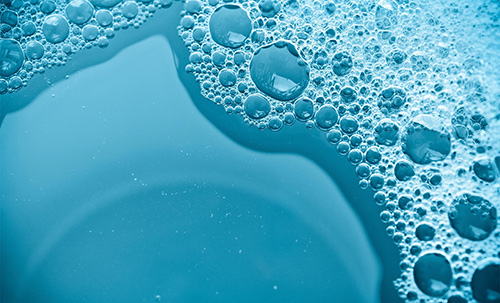Using anti-foam in amine sweeting process
Any liquid will produce froth or foam if gas is introduced into the liquid faster than the two phases disengage. The “disengagement”, or “break time” differentiates froths from foams in amine treating processes. Free liquid captured between the gas bubbles begins to drain as the bubbles rise past the bulk gas – liquid interface. The free liquid will drain from around the gas bubble until the gas pressure inside the bubble is greater than the liquid wall’s surface or interfacial surface tension. At this point the bubble will either break or combine with other surrounding bubbles (coarsening).
The more stable or elastic the bubble wall, the more resistant the bubble will be to breaking. If bubbles are being formed faster than the existing ones are breaking, they will accumulate as foam. When the formation and break time are equal, a stable foam column is formed. Anything chemical or environmental that affects free liquid drainage, or bubble wall elasticity will directly affect the resulting foam’s break time.
Amine process towers with trayed internals are especially prone to foaming upsets because they are designed to produce froth by violently bubbling gas through the treating solution contained on the trays. The bubble walls in the froth act as mass transfer area for the removal of the gas borne contaminants. The froth bubbles break quickly enough for the treating liquid to pass down to the next tray in the column before the gas flow is restricted.
If anything increases the gas/liquid disengagement time, the froth will remain in the vapor space of the tray, and the gas flow will be restricted. This hydraulic restriction is detected as a differential pressure above and below the froth in the vapor space. This condition is described as solution foaming. A variety of solution contaminants and operating conditions can cause froth to stabilize into foam. Figure 1 shows the foaming formation and anti-foam mechanism.

Fig. (1): Foam formation and antifoam mechanism
Since foaming in amine plants causes upsets, mitigation actions have been employed to avoid its formation. The first mitigation action is normally the addition of chemical antifoam. Antifoams are intended to facilitate gas and liquid disengagement by weakening the cell structure of the bubbles. Antifoams have no positive contaminant removal properties. The injection of these chemicals into recirculating amine solutions is common, and even regarded as necessary for normal plant operation.
When operators have to inject antifoaming chemicals into a recirculating amine solution, it almost always has to be used again in the near future. Antifoams are not soluble chemicals. They do not become part of the amine solution, but rather are suspended as immiscible droplets or bubbles. They have to remain in suspension to be effective.
Antifoams may become ineffective in a variety of ways. First and probably most common is their removal. Activated carbon and tight mechanical filters can remove antifoam from the amine stream. Even more open mechanical filters become more efficient as they plug, and may remove or coalesce AFA. Antifoam may not be completely removed by the filters. The larger droplets may extrude through the filters due to the differential pressure after the coalescence of many smaller 1-10 micron droplets.


